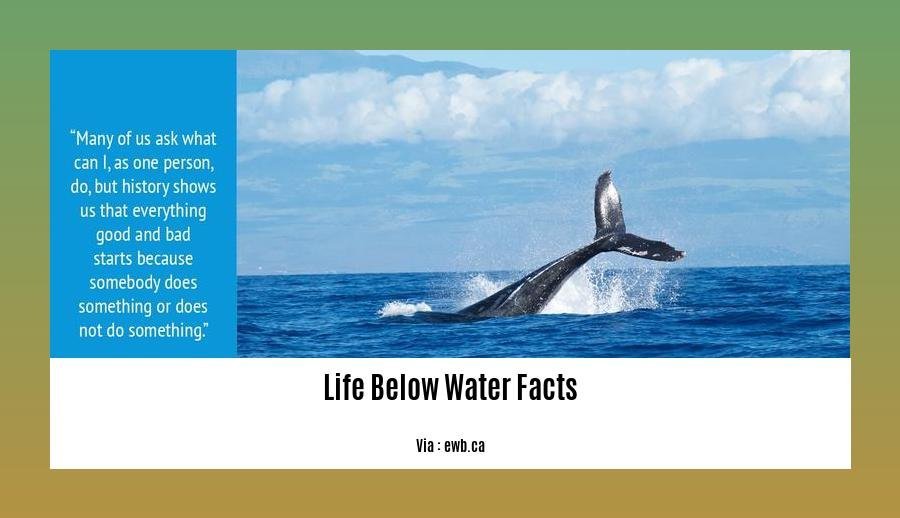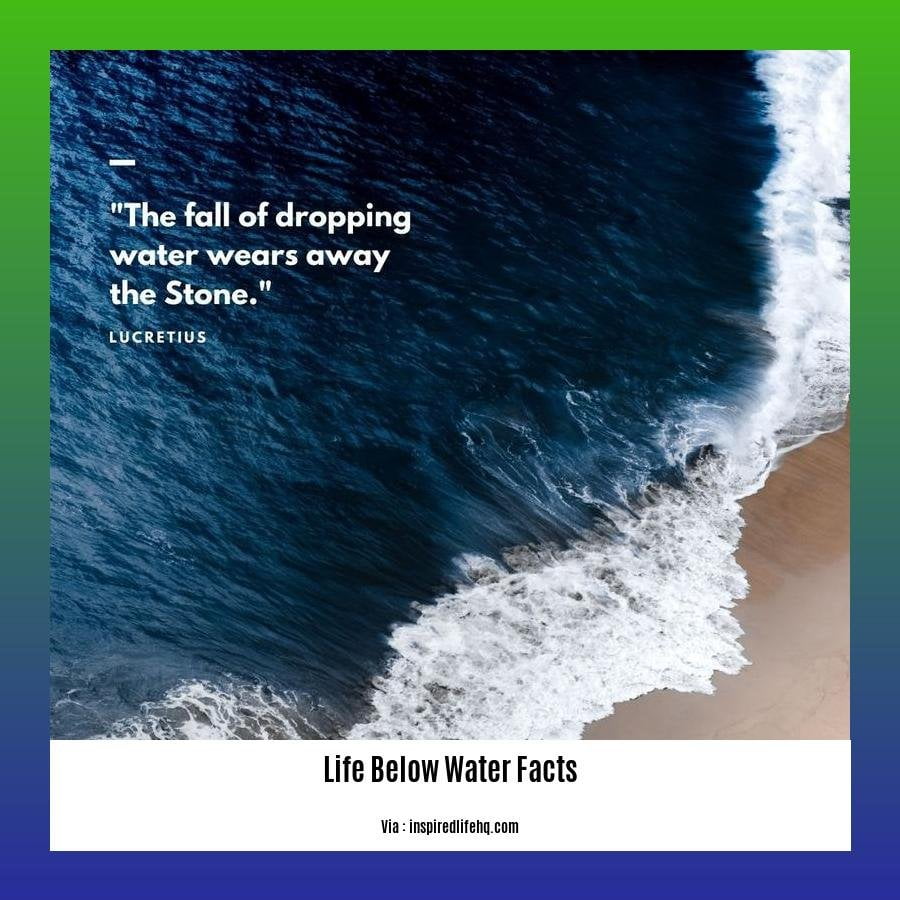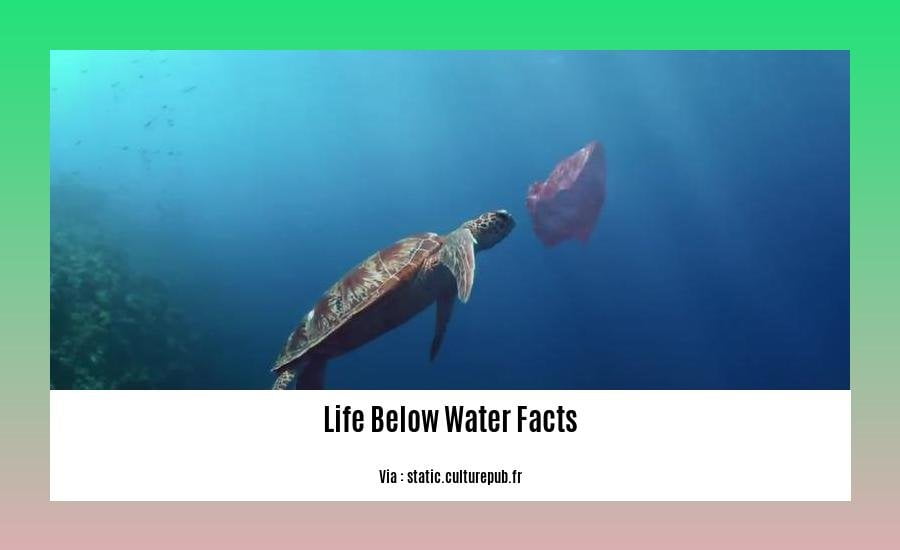Welcome to the mesmerizing realm of marine life, where the depths of the ocean hold captivating mysteries waiting to be unveiled. Join us as we embark on a thrilling journey with “Exploring the Enigmatic Realm: Unveiling Life Below Water Facts.” Prepare to dive into uncharted waters and discover the incredible diversity, secrets, and extraordinary resilience of marine ecosystems.
Key Takeaways:
Over 200 million people rely on marine fisheries for their livelihoods.
Only 65.8% of fish stocks were within sustainable levels in 2017, a significant decrease from 90% in 1974.
80% of marine and coastal pollution originates on land.
94% of life on Earth exists in the ocean, and we currently know about a quarter-million marine species.
Only about 5% of the ocean has been explored.
Oceans play a crucial role in controlling greenhouse gases.
The longest mountain range in the world is located underwater, stretching for over 40,000 miles.
Corals can produce their own sunscreen to protect themselves from harmful UV radiation.
Some fish, like the sailfish, can reach incredible speeds of up to 70 miles per hour.
Over 3 billion people rely on marine ecosystems for their livelihoods, and the goods and services provided by the ocean are valued at over US$2.5 trillion per year.
We only know about 230,000 of the estimated 2 million living species in the ocean.
Life Below Water Facts: Unveiling the Mysteries of the Underwater World

In a world teeming with secrets, the oceans remain a grand enigma, holding within them the wonders of life below water. Delving into these depths, we’ve unveiled a treasure trove of fascinating facts about the undersea realm.
Diversity of Species:
Did you know that the ocean is home to a mesmerizing array of creatures? Out of the known 2 million species on Earth, only about 230,000 reside in this vast blue expanse. It’s a testament to the diversity that awaits discovery within the underwater realm.
Pollution Threats:
Sadly, the oceans bear the brunt of our terrestrial activities, with an astounding 80% of marine pollution originating from land. This pollution poses a grave threat to marine life, jeopardizing the delicate balance of ecosystems.
Economic Significance:
The oceans are not just a haven for marine life; they’re also a vital economic engine. Over 3 billion people depend on marine ecosystems for their livelihoods, and the goods and services provided by the ocean are valued at an astounding US$2.5 trillion per year.
Untapped Potential:
Despite our advancements, only 5% of the ocean has been explored. Imagine the wealth of knowledge and resources still hidden within these uncharted waters. It’s a testament to the vastness and mystery of the underwater world.
Climate Regulators:
Our oceans are not just teeming with life; they’re also crucial players in regulating the Earth’s climate. They absorb carbon dioxide and produce oxygen, serving as a vital buffer against climate change.
Remarkable Adaptations:
Marine creatures have evolved incredible adaptations to survive in their unique environment. From anglerfish that lure prey with bioluminescent “fishing rods” to deep-sea fish that withstand extreme pressures, the ocean is a showcase of nature’s ingenuity.
Astonishing Speed:
Some fish are built for speed. The sailfish, for example, can sprint through the water at speeds of up to 70 miles per hour. Imagine the thrill of witnessing such speed and grace in the ocean’s depths.
Coral Sunscreen:
Corals have an amazing ability to protect themselves from harmful UV radiation. They produce their own sunscreen, a testament to their resilience and the wonders of evolution.
Longest Mountain Range:
Beneath the waves lies the longest mountain range in the world, stretching for over 40,000 miles. This underwater behemoth dwarfs even the mighty Himalayas, a reminder of the hidden wonders that lie just beyond our sight.
As we continue to explore and learn from the life below water, we gain a deeper appreciation for the incredible diversity, interconnectedness, and resilience of marine ecosystems. It’s a realm of wonder, beauty, and profound ecological importance, one that we must all strive to protect and preserve for generations to come.
Are you a curious mind seeking intriguing knowledge? Discover lesser-known interesting facts about forensic science.
Are you aware of the fascinating properties of zinc metal? Explore a compendium of facts about zinc metal that will astound you.
Have you ever pondered the marvels of life on land? Unveil the wonders of facts about life on land and be captivated by nature’s wonders.
Economic Significance: Marine Ecosystems Support Global Economies through Fisheries, Aquaculture, and Coastal Tourism, Contributing to Livelihoods and Food Security.

Marine ecosystems are a powerhouse of economic activity, supporting livelihoods and contributing to food security around the world.
1. Fisheries: A Lifeline for Coastal Communities
Global marine fisheries are a vital source of protein, providing food and income for millions of people. Whether it’s small-scale artisanal fishing or large-scale commercial operations, fisheries play a crucial role in supporting coastal communities and economies.
2. Aquaculture: Feeding the Future with Sustainable Seafood
With the world’s population on the rise, aquaculture has emerged as a sustainable and efficient way to meet the growing demand for seafood. By harnessing the power of marine ecosystems, aquaculture provides a reliable source of food and creates jobs in coastal regions.
3. Coastal Tourism: A Catalyst for Economic Growth
The allure of the ocean draws tourists from far and wide, generating revenue and creating employment opportunities. Coastal tourism, including diving, snorkeling, and whale watching, not only showcases the beauty of marine ecosystems but also contributes significantly to local economies.
Key Takeaways:
- Marine fisheries provide food and income for millions of people worldwide, supporting coastal communities and economies.
- Aquaculture offers a sustainable solution to meet the growing demand for seafood, creating jobs and providing a reliable food source.
- Coastal tourism leverages the beauty of marine ecosystems to generate revenue and create employment opportunities.
Sources:
- World Bank: The Ocean Economy
- UNCTAD: Blue Economy
Threats to Marine Biodiversity: Overfishing, pollution, climate change, and habitat destruction pose serious threats to marine life, leading to species endangerment and ecosystem disruption.
Overfishing:
The relentless pursuit of fish for food and economic gain has resulted in overfishing, a major threat to marine ecosystems. Exceeding sustainable limits, overfishing depletes fish stocks, leading to a decline in biodiversity and disruption of food webs.
Pollution:
The ocean, once pristine, now bears the brunt of pollution from various sources. Industrial waste, plastics, and agricultural runoff contaminate marine habitats, harming marine life and disrupting ecosystems. Pollution can cause direct toxicity, habitat degradation, and entanglement, leading to reduced biodiversity.
Climate Change:
The rising global temperatures due to greenhouse gas emissions have profound impacts on marine ecosystems. Warming oceans lead to coral bleaching, disrupting fragile coral reef ecosystems. Ocean acidification, caused by increased carbon dioxide levels, threatens the survival of marine organisms with calcium carbonate shells or skeletons, such as shellfish and corals.
Habitat Destruction:
The destruction of critical marine habitats, such as coral reefs, mangroves, and seagrass beds, poses a significant threat to marine biodiversity. These habitats provide food, shelter, and breeding grounds for various marine species. Human activities, including coastal development, dredging, and oil exploration, contribute to habitat destruction, leading to the loss of biodiversity and ecosystem disruption.
Key Takeaways:
– Overfishing: Excessive fishing practices deplete fish stocks, leading to biodiversity loss and food web disruption.
– Pollution: Industrial waste, plastics, and agricultural runoff contaminate marine habitats, harming marine life and causing ecosystem disruption.
– Climate Change: Rising temperatures and ocean acidification threaten marine life and disrupt ecosystems, such as coral reefs.
– Habitat Destruction: Human activities, such as coastal development, dredging, and oil exploration, destroy critical marine habitats, leading to biodiversity loss and ecosystem disruption.
Citations:
– National Oceanic and Atmospheric Administration (NOAA): Threats to Marine Life
– World Wildlife Fund (WWF): Threats to the Ocean
International Collaboration: Protecting Marine Biodiversity Requires Global Cooperation
In the vast expanse of our world’s oceans, a vibrant tapestry of life thrives, holding secrets and wonders that captivate the imagination. Protecting this marine biodiversity is not just a responsibility but a necessity for the health of our planet and the well-being of future generations.
The Imperative of International Collaboration
The sheer scale and interconnectedness of our oceans demand a collaborative effort that transcends national boundaries. We’ve seen the devastating consequences of fragmented approaches to marine conservation. Overfishing, pollution, and habitat destruction don’t respect borders; they require a united front to address them effectively.
Cornerstones of International Cooperation
At the heart of this collaboration lie several key initiatives:
Marine Protected Areas: Creating safe havens for marine life, these areas provide respite from human activities, allowing ecosystems to flourish and biodiversity to thrive.
Sustainable Fisheries Management: Implementing responsible fishing practices ensures that we can continue to reap the benefits of marine resources without compromising the long-term health of fish stocks.
International Agreements: Establishing legally binding agreements, such as the Convention on Biological Diversity and the United Nations Convention on the Law of the Sea, provides a framework for cooperative action and shared responsibilities.
Examples of Success
Collaboration has already yielded tangible results. The North Atlantic Marine Mammal Commission has successfully coordinated efforts to protect marine mammals, leading to the recovery of several species. The International Whaling Commission has played a crucial role in regulating whaling and promoting sustainable practices.
Challenges and the Path Forward
Despite these successes, challenges remain. Balancing the need for economic development with marine conservation requires careful planning and compromise. Ensuring equitable access to marine resources and benefits, especially for developing nations, is essential for fostering a truly sustainable approach.
Key Takeaways:
- International collaboration is paramount to protect marine biodiversity, addressing threats that transcend national borders.
- Marine protected areas, sustainable fisheries management, and international agreements form the cornerstones of this collaboration.
- Collaboration has led to tangible successes, demonstrating the power of collective action.
- Challenges remain in balancing economic development and conservation, ensuring equity, and promoting sustainable practices.
Sources:
FAQ
Q1: What factors contribute to overfishing in the world’s oceans?
A1: Overfishing is primarily driven by excessive demand for seafood, inefficient fishing practices like bottom trawling, and inadequate regulations and enforcement.
Q2: What are the ecological consequences of overfishing?
A2: Overfishing leads to degraded marine ecosystems, declines in biodiversity, disruption of food chains, and reduced fish stocks, ultimately affecting marine life and ocean health.
Q3: How does overfishing impact global food security?
A3: Overfishing threatens food security by reducing fish availability and affordability, particularly affecting communities that rely on fisheries as a primary source of food and income.
Q4: What measures can be taken to promote sustainable fishing practices?
A4: Sustainable fishing practices include implementing selective fishing methods, establishing marine reserves, and strengthening fisheries management with catch limits and quotas.
Q5: What is the significance of the High Seas Treaty in protecting marine biodiversity?
A5: The High Seas Treaty is a landmark achievement that aims to conserve and sustainably use marine biological diversity in international waters, covering nearly half of the Earth’s surface. It establishes a framework for marine protected areas, regulates fishing activities, and promotes benefit-sharing from marine genetic resources.












